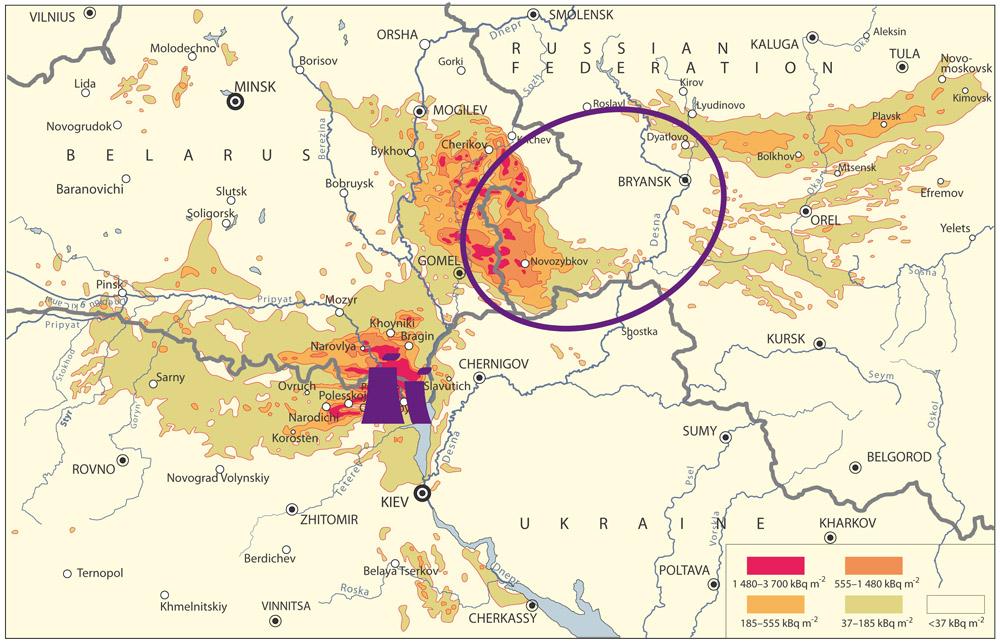Health consequences of low-dose radiation exposure in the context of a nuclear accident
The epidemiological study EPICE provides well-documented answers regarding non-cancerous radiation-induced effects. This study does not observe an association between cardiac arrhythmia and caesium-137 deposition levels on children living in the Bryansk region exposed to Chenobyl fallout.
The scientific evidence currently available about the possible health consequences of accidental exposure to ionizing radiation is mainly based on lessons learned from the follow-up of A-bomb survivors (Hiroshima and Nagasaki) in Japan, as well as populations exposed to fallout from the Chernobyl accident in Belarus, Ukraine and Russia. The observed effects vary according to the type of radiation exposure, dose rate and study population.
In the long term (a few years to decades), an increase in the risk of leukemia and cancers has been observed among the Japanese survivors of the Hiroshima and Nagasaki bombings, as well as an increase of thyroid cancer in children exposed to fallout from the Chernobyl accident in Belarus, Ukraine and Russia.
With respect to non-cancerous effects, a relationship between the risk of cardiovascular disease and exposure to ionizing radiation was observed in the survivors of the Hiroshima and Nagasaki bombings and in Chernobyl liquidators; a similar observation was made for lens opacities (early stage of cataract) and exposure. However major uncertainties remain over the existence of such low-dose associations.
To address this issue, IRSN set up in 2005 the EPICE program (Evaluation of Pathologies potentially Induced by chronic CEsium contamination) in order to gather scientific information on non-cancerous effects resulting from chronic low-dose ionizing exposures and to answer a societal question relating to the health consequences of the Chernobyl nuclear accident in a sensitive population (children).
Territories and population included in the EPICE study

© UNSCEAR - caesium-137 soil deposition
The region of Bryansk, in Russia, is located to the north-east of the Chernobyl nuclear power plant. Part of the region was affected by the Chernobyl fallout. The EPICE study focused on systematic screening for cardiac arrhytmias in nearly 18,000 children aged 2 to 18 living in the contaminated (137Cs deposit > 37 kBq/m²) and uncontaminated territories of the Oblast.

After a pilot phase to demonstrate the feasibility of the project and to determine conditions for the implementation of an epidemiological study in a population of several thousand children, the second part of the EPICE program focusing on cardiac arrhythmias started in May 2009 in collaboration with Bryansk Diagnostic Center (Russia).
The purpose of this cross-sectional study was to determine the prevalence of cardiac arrhythmias (in terms of the territory contamination and caesium-137 whole-body burden in the study population) in the southwestern part of Russia close to the Ukrainian and Belorussian borders, and to assess whether or not caesium-137 was an associated factor in the occurrence of cardiac arrhythmias.
To solve these questions, a measurement campaign was conducted on 18,152 children aged 2 to 18 years old during four years. It consisted of performing systematically an electrocardiogram, a cardiac ultrasound and an assessment of the caesium-137 whole-body activity for the entire population of the study. In addition, some children also benefited from a 24-hour monitoring of cardiac electrical parameters (Holter) as well as a biological assessment of major plasma cardiac biomarkers.
Crude prevalence of cardiac arrhythmia in the Bryansk region (2009-2013)

Crude prevalence of cardiac arrhythmia in the Bryansk region considering caesium-137 burden (2009-2013)

All of these medical examinations diagnosed 2,526 children with cardiac arrhythmia. As a result of a thorough statistical analysis of the data collected on the field, over the period 2009-2013, the prevalence of cardiac arrhythmias estimated in the contaminated territories is significantly lower than in the controlled territories. With regard to caesium-137 whole-body burden, no association could be demonstrated. Therefore, caesium-137 is not an associated factor in the occurrence of cardiac arrhythmia in the frame of the study.
This epidemiological study, which is unique in terms of its size and the quantity of data collected, thus provides well-documented answers regarding non-cancerous radiation-induced effects in children living in Russian contaminated territories by the fallout from the Chernobyl accident, issue which is widely discussed for many years.
This article, published in BMJ Open (open access version of the prestigious journal The British Medical Journal), is the first in a series of future publications on the results of the EPICE program, including the conclusions of a study on a large-scale screening of lens opacities in a similar group of children living in the same region of Russia.
Download the article published in BMJ Open “Is exposure to ionising radiation associated with childhood cardiac arrhythmia in the Russian territories contaminated by the Chernobyl fallout? A cross-sectional population-based study” (PDF, 408 Ko)
